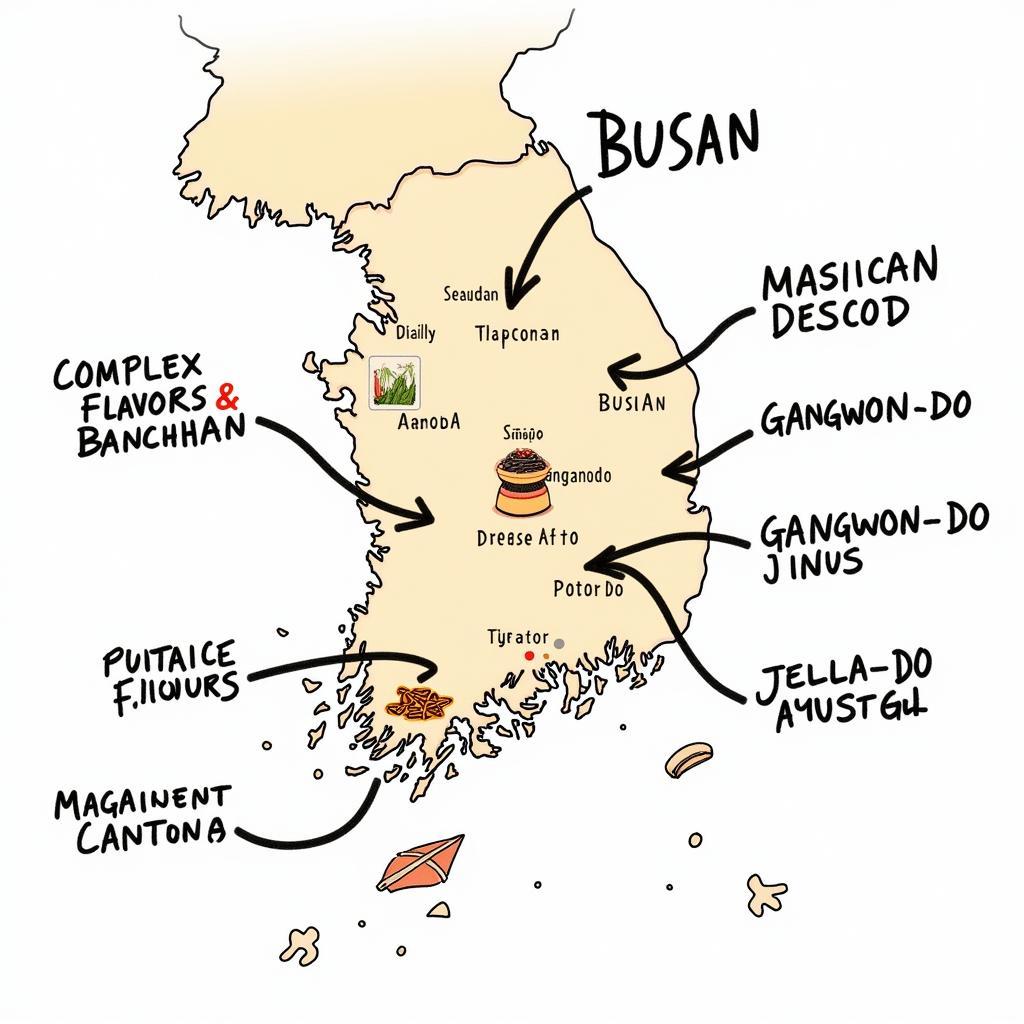South Korean food, a vibrant tapestry of flavors and traditions, has captivated the world with its bold spices, unique ingredients, and communal dining experiences. From the fiery kimchi that graces almost every meal to the comforting warmth of bibimbap, Korean cuisine offers a fascinating journey for the adventurous palate. This article delves into some surprising Facts About South Korean Food that will deepen your appreciation for this culinary gem.
Beyond Kimchi: Unveiling the Secrets of South Korean Cuisine
While kimchi is undoubtedly a cornerstone of Korean cuisine, there’s so much more to discover beyond this fermented cabbage dish. Korean food is deeply rooted in the principles of balance and harmony, reflecting the country’s agricultural heritage and philosophical beliefs. The use of fermented ingredients, like kimchi and gochujang (fermented chili paste), not only adds depth of flavor but also contributes to gut health, a concept that has gained significant traction in recent years. The vibrant colors in Korean dishes aren’t just for aesthetics; they represent the five elements of traditional Korean philosophy – wood, fire, earth, metal, and water – further emphasizing the holistic approach to food. Did you know that many Korean dishes are also naturally gluten-free, relying on ingredients like rice, noodles made from sweet potato starch or buckwheat, and an abundance of fresh vegetables?
A Feast for the Senses: Exploring Regional Variations in Korean Food
Just as diverse as its landscapes, South Korean food boasts distinct regional variations. Each region prides itself on its unique specialties and culinary traditions, shaped by local ingredients and cultural influences. For instance, the coastal city of Busan is renowned for its fresh seafood, while the mountainous region of Gangwon-do is known for its hearty potato-based dishes. Jeolla-do, in the southwest, is considered the culinary heartland of Korea, famed for its complex flavors and elaborate banchan spreads. Exploring these regional variations provides a deeper understanding of the country’s rich culinary heritage.
 Map highlighting regional Korean food specialties
Map highlighting regional Korean food specialties
More Than Just a Meal: The Social Significance of South Korean Food
In South Korea, food is more than just sustenance; it’s a social glue that binds communities together. Meals are often shared family-style, with dishes placed in the center of the table for everyone to enjoy. This communal dining experience fosters a sense of togetherness and strengthens social bonds. From the elaborate table settings of traditional Korean feasts to the casual sharing of street food snacks, food plays a central role in Korean social life.
What is the significance of Banchan in Korean meals?
Banchan, the small side dishes that accompany every Korean meal, are a testament to the Korean philosophy of balance and variety. These small, yet flavorful dishes, ranging from kimchi and seasoned spinach to pickled radish and fish cakes, ensure a diverse and balanced nutritional intake.
How does Korean dining etiquette reflect cultural values?
Korean dining etiquette, such as waiting for the eldest person at the table to start eating and using two hands to receive or offer food, reflects the deep-rooted respect for elders and the emphasis on communal harmony in Korean culture.
Facts About South Korean Food: A Culinary Adventure Awaits
From its vibrant flavors and health-conscious ingredients to its rich history and social significance, South Korean food offers a culinary adventure unlike any other. Whether you’re a seasoned foodie or a curious beginner, exploring the world of Korean cuisine is sure to be a rewarding experience.
 Korean BBQ grilling experience with friends
Korean BBQ grilling experience with friends
FAQ: Your Questions About South Korean Food Answered
- What is the most popular Korean dish? While kimchi is ubiquitous, bibimbap (mixed rice with meat and vegetables) and Korean BBQ are also incredibly popular.
- Is Korean food spicy? Many Korean dishes incorporate chili, but the level of spiciness can vary greatly. There are also plenty of mild options available.
- Where can I find authentic Korean food? Korean restaurants are becoming increasingly common worldwide. Look for restaurants that offer a variety of banchan and traditional dishes.
- What are some essential ingredients in Korean cooking? Soy sauce, garlic, ginger, sesame oil, gochujang (fermented chili paste), and doenjang (fermented soybean paste) are staples in Korean kitchens.
- Are there vegetarian options in Korean cuisine? Yes, many Korean dishes are naturally vegetarian or can be easily adapted, focusing on vegetables, tofu, and rice.
- What is the difference between Korean and Japanese food? While both cuisines share some similarities, Korean food tends to be spicier and incorporates more fermented ingredients. Japanese cuisine often emphasizes subtlety and delicate flavors.
- What are some popular Korean street foods? Tteokbokki (spicy rice cakes), kimbap (seaweed rice rolls), and hotteok (sweet pancakes) are popular street food treats in Korea.
Common Scenarios and Questions
- Scenario: You’re planning a trip to South Korea and want to know what foods to try. Question: What are some must-try regional specialties in South Korean cuisine?
- Scenario: You’re hosting a Korean-themed dinner party. Question: What are some easy Korean recipes for beginners?
- Scenario: You’re trying to eat healthier. Question: What are some healthy and nutritious Korean dishes?
Explore More About Korean Cuisine on Mina Cones Food
- Check out our article on the health benefits of kimchi.
- Learn more about the art of making Korean BBQ at home.
- Discover our favorite Korean dessert recipes.
Need assistance? Contact us at Phone: 02437655121, Email: [email protected] or visit us at 3PGH+8R9, ĐT70A, thôn Trung, Bắc Từ Liêm, Hà Nội, Việt Nam. We have a 24/7 customer service team.